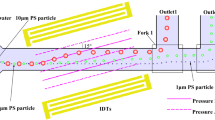Abstract
In this research, a rapid prototype hydrodynamic focusing module with three multi-fluidic speed-modulating (MFSM) micropumps in micro-fluidic flow has been designed, fabricated, and characterized. The module comprises of three MFSM micropumps having the dimension of 33 × 25 × 5 mm to achieve hydrodynamic focusing and the stream modulation. Each micropump consists of top, middle and bottom including actuation/modulation source, PDMS/nickel-particle composite (PNPC) diaphragm and Tesla-type valve/chamber, respectively. Three MFSM micropumps share one pneumatic actuation source and two individual permanent magnet modulation sources which are located above the right and left diaphragms. Each permanent magnet is manually controlled by a screw. The PNPC diaphragm deflection is obtained by the external pneumatic force, and the permanent magnet limits the displacement resulting from the interaction between the magnetic field and the nickel particles of the PNPC diaphragm. Hydrodynamic focusing is realized by the flow rate control of two side micropumps with magnetic diaphragm displacement modulation. Analyses of the magnetic modulation field, the flow rate of the MFSM micropump, and the hydrodynamic focused stream modulation are presented. The individual micropump can pump DI water with a flow rate of about 107 μl/min, and the hydrodynamic focusing channel can achieve a flow rate of about 321 μl/min, under the frequency of 2 Hz. This research examines the modulation feasibility of hydrodynamic focused center stream by controlling the neighboring stream flow rate and this technique can be utilized for possible applications in lab-on-a-chip, micro total analysis system and point of care testing system.










Similar content being viewed by others
References
Choong CL, Milne WI, Teo KBK (2008) Review: carbon nanotube for microfluidic lab-on-a-chip application. Int J Mat Form 1:117–125
Frische N, Datta P, Goettert J (2010) Development of a biological detection platform utilizing a modular microfluidic stack. Microsyst Technol 16:1553–1561
Gamboa AR, Forster FK (2004) Is there a best fixed-geometry valve for micropumps? In: Proceedings of IMECE 2004, ASME, Fluids engineering. Anaheim, California, pp 319–324
Gamboa AR, Morris CJ, Forster FK (2005) Improvements in fixed-valve micropump performance through shape optimization of valves. J Fluids Eng 127:339–346
Gervais L, de Rooij N, Delamarche E (2011) Microfluidic chips for point-of-care immunodiagnostics. Adv Mater 23:H151–H176
Gravesen P, Branebjerg J, Jensen OS (1993) Microfluidics-a review. J Micromech Microeng 3:168–182
Laser DJ, Santiago JG (2004) A review of micropumps. J Micromech Microeng 14:R35–R64
Morris CJ, Foster FK (2003) Low-order modeling of resonance for fixed-valve micropumps based on first principles. J Microelectromech Syst 12:325–334
Pirmoradi F, Cheng L, Chiao M (2010) A magnetic poly(dimethylesiloxane) composite membrane incorporated with uniformly dispersed, coated iron oxide nanoparticles. J Micromech Microeng 20:1–7
Price CP, St. John A, Hicks JM (2004) Point-of-care testing, 2nd edn. American Association for Clinical Chemistry Press, London
Puntambekar A, Ahn CH (2002) Self-aligning microfluidic interconnects for glass- and plastic-based microfluidic systems. J Micromech Microeng 12:35–40
Sorger PK (2008) Microfluidics closes in on point-of-care assays. Nat Biotechnol 26:1345–1346
Suzuki H, Yoneyama R (2003) Integrated microfluidic system with electrochemically actuated on-chip pumps and valves. Sens Actuators B 96:38–45
Tesla N (1920) Valvular Conduit. US Patent 1,329,559
Truong T-Q, Nguyen N-T (2003) Simulation and optimization of tesla valves. Nanotech 1:178–181
Zheng S, Yung R, Tai Y-C, Kasdon H (2005) Deterministic lateral displacement MEMS device for continuous blood cell separation. In: MEMS, pp 851–854
Acknowledgments
This work has been supported by Louisiana Board of Regents under Project No. LEQSF(2007-12)-ENH-PKSF11-PRS-04.
Author information
Authors and Affiliations
Corresponding author
Rights and permissions
About this article
Cite this article
Kim, J., Kang, KN., Jin, Y. et al. Hydrodynamic focusing micropump module with PDMS/nickel-particle composite diaphragms for microfluidic systems. Microsyst Technol 21, 65–73 (2015). https://doi.org/10.1007/s00542-014-2089-8
Received:
Accepted:
Published:
Issue Date:
DOI: https://doi.org/10.1007/s00542-014-2089-8




